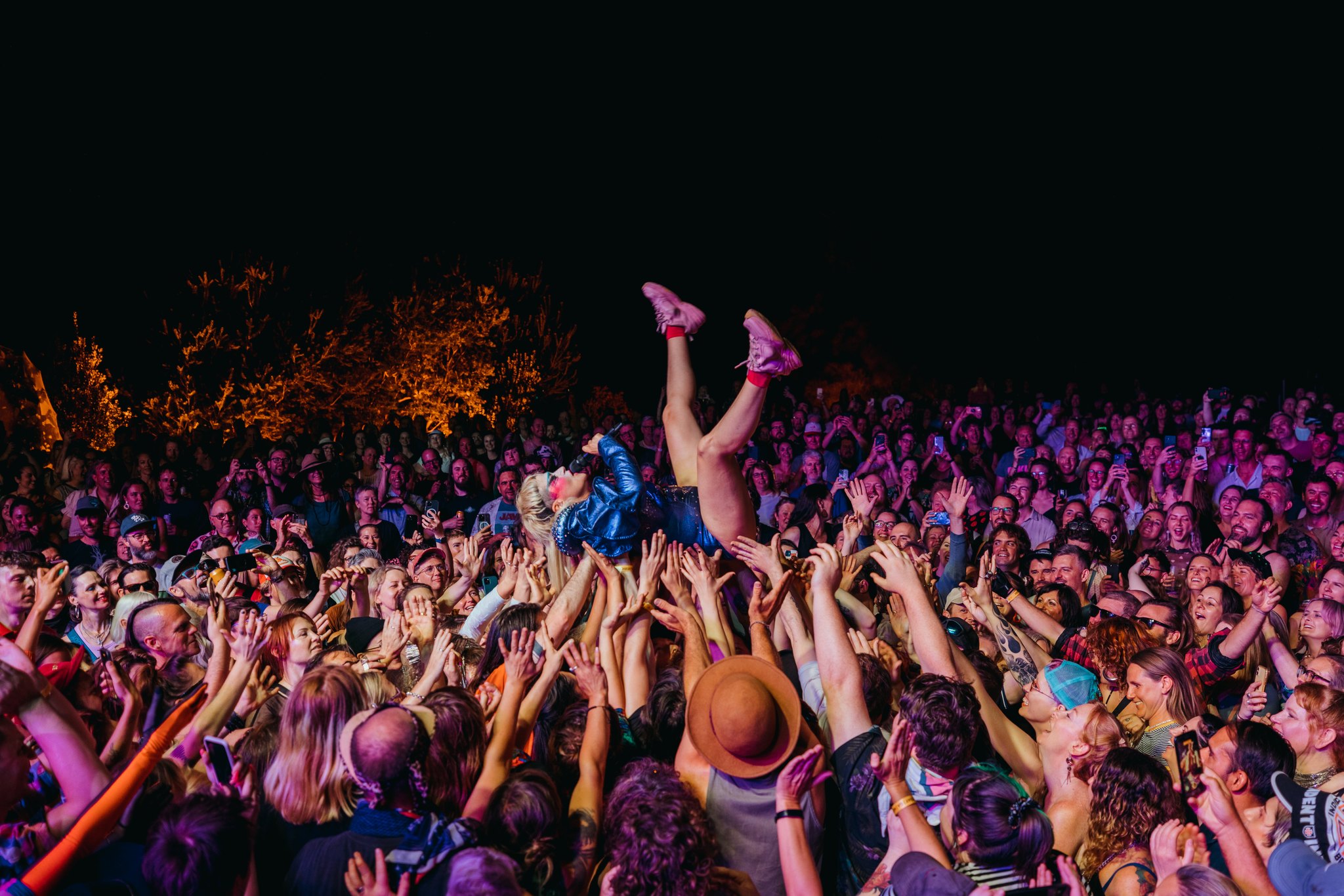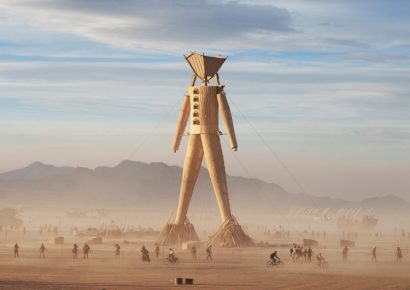It's Sunday, the last night of Hobart’s Mona Foma. I reach the top of the 99 stairs to the sound of pounding beats: the final hour of Chloe Kim's 100 hours of drumming.
In the golden light between showers on the Mona hilltop she is still drumming and smiling. A small crowd in front of her dances, flailing and spinning and bouncing. She laughs, and it might be at them or from exhaustion and relief at how close her challenge is to being finished.
We’ve just come from A Life Sentence, the Nico Muhly / Tasmanian Symphony Orchestra Chorus performance: a live Muhly composition as well as songs prepared from a single line of poetry, chosen by the audience. In the fading long weekend light, two of them spring to mind:
- I wonder how I can crowd all my joys into one short life.
- And thus we drift toward unparalleled catastrophe.
The tension of these could be applied to most of the events festival program, dealing in joys, fears, futures and endings.
And it applies to the tail end of any four-day festival party, shuttling between arts, events, ideas, blackened rooms and sun-drenched lawns, silence and ear-ringing rock concerts. Doing all of Mona Foma Hobart, crowding joys into one short weekend, holding steady against the drift.
Explore Melbourne’s latest arts and stage events, exhibitions, productions and performances here.
Mona’s festivals have an aspect of endurance about them. Sometimes it’s challenging the artists and participants to perform feats and engage with unusual experiences – think, previous Dark Mofos where Mike Parr was buried alive beneath bitumen or audiences endured three hours and five hundred litres of animal blood in 150.Action. Compared to the extremes of its darker sibling, Chloe Kim performing 100 hours of drumming for Foma could seem a tame feat.
For Mona Foma, outside those months of darkness, it feels a lot more like art that provokes through joy and possibility, while allowing for our necessary grief and fear. Challenging broader ideas, for a better world. It’s fitting that the Museum of Old and New Art makes a point of positing the new ways that art could be.
For one thing, there are the interpreters. Peaches – goddess provocateur – stripped, performed in an inflatable penis, grabbed defiantly at her own flesh and howled for pleasure on the Mona Sessions stage. Then she brings the Auslan interpreter to the front so we can all see obscenities and sex articulated in the vigorous language of hands. The crowd goes wild at unspeakable acts spoken with the body.
Again, during one song in A Life Sentence, the choir goes silent, mouths moving, deep breaths in diaphragm, but no sound, as an interpreter communicates lyrics in Auslan and makes music for the deaf. We see accessibility and inclusivity enriching art rather than being a concession made or a box ticked.
Mona Foma explores the tension between hope and fear. Not just the usual Mona ‘Sex And Death’. There is less of the midwinter brutality, no burning effigies, no destruction.
A festival for the feeling of daylight hours. Humans connected in different ways.
Our opening ceremony begins as a sun-beaten heady experience of grace. Heat and smoke, song and story. On unceded land, people from across the world converge at this point and are welcomed to Country by Yindjibarndi, Ngnarluma and Walmatjarri Elders and members of the Palawa community. And it’s carried through Foma in acknowledgements and voices of country that open the Theatre Royal performances. Mutti Mutti songman Kutcha Edwards sings on the first and last nights, bringing generosity and strength through a history of sorrows, sharing a vision and determination that we must build better and seek more.
Is Foma just Mona’s summer song? Where desert rock legend of Mali, Vieux Farka Toure, whips us into vigorous dance more reminiscent of nights in a muddy Bluesfest tent. Where we drink the wine from vines within spitting distance of the Sessions stage, eating the Yula (muttonbirds) that once flew, given to us by the generous hands of Palawa Kipli. Where artists like Peaches, Bikini Kill and Pavement – icons of their eras – become a joyful reunion, a convergence of old fans, new generations, teens too young to remember who can hear the rallying riot grrrl cry and know we still need that, decades on. The songs sound the same, time collapses, ecstatic dance in shadows and light shows. Where 40 years on from the death of John Pat, people must still sing Songs For Freedom and mingle momentous grief with love and pride.
We are shunted between light and dark between and within each Foma performance. There are warnings in A Deep Black Sleep, an alienating opera of an authoritarian rise that disjoints us, disarticulates and makes strange our human expression. In Climate Notes, Anna McMichael and Louise Devenish throw eco-anxiety and letters of hope in patterns on a screen, a tension of strings and spoken words.
I might read too much in the transformative dance of Baby Girl, juddering movements of an altered dancer’s body, entering a cocoon and emerging with sinuous, slow form, walking as though through a dream. Becoming new. In it I see a performance of gender, from a conflicted masculine state, transitioning to an altered feminine embodiment. But I run into the dancer, Amber McCartney, on the lawn as we wait for Peaches, I say what I saw and she says, politely, that is not it at all. Maybe I could blame the heat of the day that delayed the delights of The Queer Woodchop, gave me a head full of sun and queer joy.
It’s a festival of collaboration and touch, pulling closer, making new spaces.
In Mona’s new recording studio, The Frying Pan, we see the future of a Tassie music scene that supports its local artists and draws in the best from around the world to collaborate. People like Nico Muhly, artist in residence who sheds his irrepressible energy and effusive joy over the festival and the artists who live here. A genius, a man who makes me cry in the only good way a man makes one cry, yet appears bouncing on stage, laughing, to praise the TSO as they play his compositions in The Odeon. Then he sits on the floor like a schoolchild at the Theatre Royal, watching in rapture as the TSO Chorus blind-sings his off the cuff composition in A Life Sentence.
And there’s an innocence to this resistance against despair on the precipice of climate collapse and political catastrophes. Hope becomes a radical act. A world where we make futures, rather than fear them.
But time is larger than our fragile lives, end to end. We are reminded in Primordial, a piece by IHOS Amsterdam composer Constantine Koukias and pianist Gabriella Smart. It grows with the overlay of each new performance at Ediacara fossil sites and will take years, with the final culmination in 2027. In the expression of deep time and tectonic movement on a piano, it is the early iteration of an artwork of strata and complexity, each layer covering the bones of the first. Some of these fossils are located in the Dneister River in Ukraine. How deep are the old bones, that they might sleep and know nothing of the war and my family above, that not even a disaster at Zaporizhzhia nuclear plant will crack and wake them? This geology will outlast ecological collapse and war.
And then we rave fearlessly at The Party until 3am, night after night, bodies and breath packed close in the Old Mercury Building in a way that would have been unthinkable not so long ago. Healed or foolish, forgetting or pretending, too full of Moo Brew and light shows to care.
There’s an intensity to doing all of Foma. A hustle of lost time. A cumulative experience. Like 100 hours of drumming and smiling into the falling sunlight, we see how much joy one body can survive as we fight the drift towards our shared, unparalleled catastrophe.
Foma Hobart is a festival of futures. What can we be and how we can shape it. Art will grow further from here, layer by layer, like PRIMORDIAL. With climate anxieties, hopes for sovereignty and justice and new spaces of possibility, we face the future with a vision.
Who is willing and able to change in all the ways we need to?
And what is the role of art in making us imagine and make these new worlds?
Look back at the Mona Foma 2023 program and find more information about the Tasmanian icon here.







